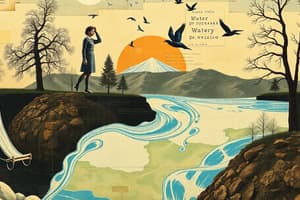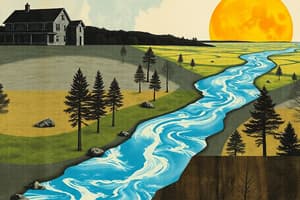Podcast
Questions and Answers
What is the summary of the circulation of Earth's water supply?
What is the summary of the circulation of Earth's water supply?
hydrologic cycle
What processes are involved in the hydrologic cycle?
What processes are involved in the hydrologic cycle?
- Precipitation
- Evaporation
- Infiltration
- All of the above (correct)
Streams and rivers are part of which cycle?
Streams and rivers are part of which cycle?
hydrologic
What is a small river or any body of water that flows through a channel called?
What is a small river or any body of water that flows through a channel called?
What is the term for the land area that contributes water to a stream?
What is the term for the land area that contributes water to a stream?
What separates the drainage basins of different streams?
What separates the drainage basins of different streams?
What is water flowing directly over the surface known as?
What is water flowing directly over the surface known as?
What is water soaking into the ground and flowing toward the stream called?
What is water soaking into the ground and flowing toward the stream called?
What is the cross-sectional view of a stream from head to mouth called?
What is the cross-sectional view of a stream from head to mouth called?
What describes the steeper sides and deeper valleys near headwaters of a river?
What describes the steeper sides and deeper valleys near headwaters of a river?
What is the lowest point to which a stream can erode?
What is the lowest point to which a stream can erode?
What are the two general types of base level?
What are the two general types of base level?
What happens when raising base level causes deposition?
What happens when raising base level causes deposition?
What is the formula for discharge in a river?
What is the formula for discharge in a river?
The velocity of a river is ______ where a river flows through a ______ canyon than where it spreads out.
The velocity of a river is ______ where a river flows through a ______ canyon than where it spreads out.
What can a river do to accommodate extra water when discharge increases?
What can a river do to accommodate extra water when discharge increases?
During what condition does the greatest erosion and transportation of sediment occur?
During what condition does the greatest erosion and transportation of sediment occur?
As a stream's discharge increases, it increases ______.
As a stream's discharge increases, it increases ______.
What term refers to the erosion of bedrock by particles carried by the stream?
What term refers to the erosion of bedrock by particles carried by the stream?
What is the term for the transported material in a stream?
What is the term for the transported material in a stream?
What are the types of load in streams?
What are the types of load in streams?
Which national monument was formed by the dissolution of limestone by carbonic acid?
Which national monument was formed by the dissolution of limestone by carbonic acid?
What is called when stream flow goes from mountains onto plains?
What is called when stream flow goes from mountains onto plains?
What is it called when stream flow goes from mountains into an ocean, lake, or pond?
What is it called when stream flow goes from mountains into an ocean, lake, or pond?
What are rivers that form deltas often divided into?
What are rivers that form deltas often divided into?
What describes streams that transport most of their load in suspension?
What describes streams that transport most of their load in suspension?
What describes a complex network of converging and diverging channels with a coarse sediment load?
What describes a complex network of converging and diverging channels with a coarse sediment load?
What are the two general types of stream valleys?
What are the two general types of stream valleys?
What type of valleys are v-shaped and feature rapids and waterfalls?
What type of valleys are v-shaped and feature rapids and waterfalls?
What type of valleys form when a stream is near base level and features back-and-forth meandering?
What type of valleys form when a stream is near base level and features back-and-forth meandering?
What is the flat area found on either side of a river channel periodically occupied by the stream during flooding called?
What is the flat area found on either side of a river channel periodically occupied by the stream during flooding called?
What are the features that include cut banks and point bars formed from stream meanders?
What are the features that include cut banks and point bars formed from stream meanders?
Why are floodplains ideal building sites?
Why are floodplains ideal building sites?
Flashcards are hidden until you start studying
Study Notes
Hydrologic Cycle
- The hydrologic cycle describes the continuous movement of Earth's water supply, encompassing various processes like precipitation and evaporation.
Processes in the Hydrologic Cycle
- Key processes include precipitation, evaporation, infiltration, runoff, and transpiration, all contributing to the movement and distribution of water.
Streams and Rivers
- Streams and rivers are integral to the hydrologic cycle, facilitating the return of water to oceans after it evaporates from the Earth's surface.
Definitions and Concepts
- A stream is defined as a small river or any flowing body of water confined to a channel.
- The drainage basin, or watershed, is the land area that contributes water to a stream.
- Divides are imaginary lines that separate one drainage basin from another.
Water Flow Types
- Surface runoff refers to water flowing over the land's surface, while groundwater flow involves water infiltrating the ground and moving below the water table toward streams.
Stream Profiles
- The longitudinal profile of a stream visually represents its gradient, which typically decreases from the headwaters to the mouth.
- A cross-sectional profile depicts steeper banks and deeper valleys near the headwaters, transitioning to wider floodplains at the river's mouth.
Base Level
- The base level is the lowest elevation to which a stream can erode, with two types being ultimate (sea level) and local or temporary.
Stream Activity Adjustments
- Changes in base level impact stream behavior; raising the base level typically leads to deposition, while lowering causes erosion.
Discharge
- Discharge is the volume of water flowing through a cross section of a stream per unit time, calculated using the formula Q = V x A (discharge = velocity x area).
- Changes in discharge can alter a river's velocity and channel characteristics; rivers can erode downward, increase channel width, or enhance velocity when discharge increases.
Erosion and Sediment Transport
- The greatest erosion and sediment transport occur during flooding events.
- A stream's discharge tends to increase as it flows downstream.
Sediment Interaction
- Abrasion involves bedrock channels and sediment grains being eroded by particles propelled by the stream, breaking down bedrock and rounding sediment grains.
Stream Load Types
- Streams carry different loads, classified into dissolved load, suspended load, and bed load, which together define the stream's total load.
Geological Features
- Timpanogos Cave National Monument formed from the dissolution of limestone via carbonic acid, highlighting the geological impact of water.
- Alluvial fans occur when stream flows transition from mountainous regions onto plains, while deltas form where streams flow into oceans, lakes, or ponds.
- Deltas consist of distributary channels that branch out from the main river.
Stream Flow Characteristics
- Meandering streams primarily transport their load in suspension, while braided streams exhibit a complex network of channels filled with coarse sediment.
Valley Types
- Stream valleys can be categorized into narrow (v-shaped, with features such as rapids and waterfalls) and wide valleys (characterized by lateral erosion leading to floodplains).
Floodplains
- Floodplains are flat areas adjacent to river channels that are periodically inundated, fostering nutrient-rich soil and suitable conditions for development.
Meanders
- Meanders arise from natural stream processes, producing features like cut banks, point bars, cutoffs, and oxbow lakes within river systems.
Studying That Suits You
Use AI to generate personalized quizzes and flashcards to suit your learning preferences.




